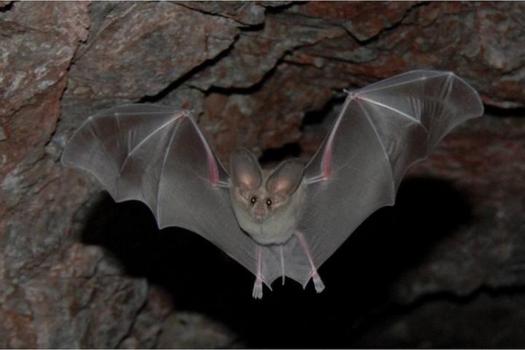Seeing with Ears
- Lesson Plan
- Video
- Interactive
- Feedback Form
How does one see in the dark? For bats, visible light isn’t necessary for survival, since they’ve adapted to “see” with their ears! Students will learn about bats, animal adaptations, and echolocation in this fun lesson.
4-LS1-1
Construct an argument that plants and animals have internal and external structures that function to support survival, growth, behavior, and reproduction.
Materials
· A copy of the ‘Amazing Echolocation’
· A blindfold
· A Lab Sheet
· A family member or friend (optional)
· EdPuzzle interactive video OR Kahoot
· Online simulation (optional)
Background
Most animals utilize light to see, just like humans do. But some animals have learned to live, hunt, and reproduce in darkness. Unique physical structures on bats support their unique way of “seeing” or sensing the world around them. The statement “blind as a bat” is inaccurate. Bats eyes can see just fine. But their eyes don’t help them when hunting and living in the dark. In order to see perfectly in darkness, they have developed an ability to map their world with sound.
The word echolocation means using “echo” to “locate”. An animal produces a sound and uses the echo of that sound to sense their surroundings. Bats can tell the size, location, and movement of an object through capturing the echoes of their high pitched squeaks or chirps. (The sounds are so high pitched that humans can’t hear them).
Physical adaptations on a bat’s body support echolocation. Special muscles in a bat’s throat allow them to make high pitched squeaks or chirps up to 190 times per second! Extra-large ears with folds allow bats to hear their squeak return echo and translate this into an abundance of information.
Other animals, such as dolphins and toothed whales use echolocation to navigate and hunt in deep dark waters. They have developed special nasal passages and skulls that allow them to “see” incredibly well.
Humans have created ultrasound technology that uses echolocation. We commonly use ultrasound/ echolocation technology in medicine (remember those first glimpses of fetuses in the womb), in deep sea fishing, and submarines.
A few amazing humans who are blind have learned to navigate their world using echolocation too!
Directions
· Start by asking your students what it would feel like to be blind. How would they get around? Navigate their world? Ask them to think about which senses they would rely upon if they could not use sight.
· Ask students how our senses integrate other information from our environment. Emphasize how the sense (hearing, smell, touch) picks up information, which our brain interprets.
· Now remind students of the Adapt and Survive activity (if you did that previously). Guide students through pointed questions to remember how animals adapt, and how natural selection can allow animals to adapt to specific environments.
· Tell them that today they will be learning about bats! Bats have special physical adaptations that allow them to thrive in darkness.
· Have students read the Amazing Echolocation by themselves or with a family remember or small student group.
· Next EITHER… Watch this video on Youtube as a class and complete the fun informal assessment Kahoot style. Discuss questions that are missed and correct misunderstandings.
https://create.kahoot.it/details/0124b53b-9db6-4c73-a309-3f0cd2126a32
· OR… Have your students watch the video “What is Echolocation?” independently and answer the questions that pop up in this Edpuzzle video.
https://edpuzzle.com/media/5fdad18c9ac5da42948beba6
· Students will now get a chance to become bats and insects, to try out echolocation themselves.
· Tell students they can play one of two games at home to test their echolocation skills. One is with a partner and one is by themselves.
Game option 1: With a family member or friend
· Explain that initially, we will have only 1 bat and 1 insect.
· Have the person be the bat. They will put on the blindfold. The other will be the insect.
· Have the bat stay in the middle of the room and chirp. Have the insect move to a side of the room away from the bat and respond to the chirp. Tell the bat to turn slowly in circles until they locate their insect. They should point at the insect before taking off the blindfold. Did they point to the correct location of the insect?
· Then switch roles for the bat and the insect and play again. Did the bat point at the insect?
Game Option 2: Individually
· If the student doesn’t have someone to do the activity with they can practice their own echolocation skills.
· Have the student stand 3 steps away, facing a wall. Put on a blindfold. Have them make a clicking noise. Can they hear the sound bouncing off the wall?
· Have them take a step closer. Does the noise change?
· Have them take another step and another until they are almost touching the wall. Has the clicking sound changed? Can they hear the echo better the closer they are to the wall?
After these activities, students may complete the lab sheet to wrap up this lesson.
Extension
· If your students are still wanting more activities about bats and echolocation, have them go to the Google Arts and Culture interactive on Carlsbad Caverns
https://artsandculture.withgoogle.com/en-us/national-parks-service/carls...
· and/or
· Try this online simulation game. Guide a bat to collect the insects as it uses echolocation. An Adobe Flash player is needed.
http://www.eduplace.com/kids/hmsc/activities/simulations/gr4/unita.html
| Attachment | Size |
|---|---|
| 174.86 KB | |
| 234.98 KB | |
| 151.23 KB |
This video produced by a Great Basin National Park bat biologist affords great background knowledge on bats for educators and can be used in the classroom as a lesson extension or closing.
Kids can explore Carlsbad Carverns and learn more about bats in this 360 degree interactive from Google Arts and Culture.
https://artsandculture.withgoogle.com/en-us/national-parks-service/carls...

